I am attempting to create a chord diagram using plot_connectivity_circle from mne_connectivity.viz library.
My data is similar to the following, where letter and number represent separate nodes and count represents the number of connections between those nodes:
import random
import string
random.seed(10)
df = pd.DataFrame({'letter':[random.choice(string.ascii_lowercase) for x in range(20)],
'number':[str(random.randint(0,22)) for x in range(20)],
'Count':[random.randint(20,50) for x in range(20)]})
The documentation for mne cites examples in which a square matrix of connectivity scores is used to create the chord diagram which differs from my use case.
However, it also states that a 1d matrix can be used for the connectivity scores if arrays of indices are also passed that correspond to the correct list of node names. Therefore I assume that df.Count can be used to represent the connectivity scores?
Given my data, I can't figure how to pass the relevant data to the node_names and indices arguments in the correct order and would appreciate some guidance please!
For reference, I have achieved a similar visualisation using the holoviews library but find the options for customisation to be lacking. Code and output for that visualisation included below as an example:
import numpy as np
import holoviews as hv
from holoviews import opts, dim
hv.extension('bokeh')
hv.output(size=350)
nodes = list(set(df['letter'].tolist() + df['number'].tolist()))
nodes = hv.Dataset(pd.DataFrame(nodes, columns=['node']))
chord = hv.Chord((df, nodes))
chord.opts(
opts.Chord(
labels = 'node', label_text_font_size='12pt',
node_color='node', node_cmap='Category20', node_size=10,
edge_color='number', edge_cmap='Category20', edge_alpha=0.9, edge_line_width=1)
)

